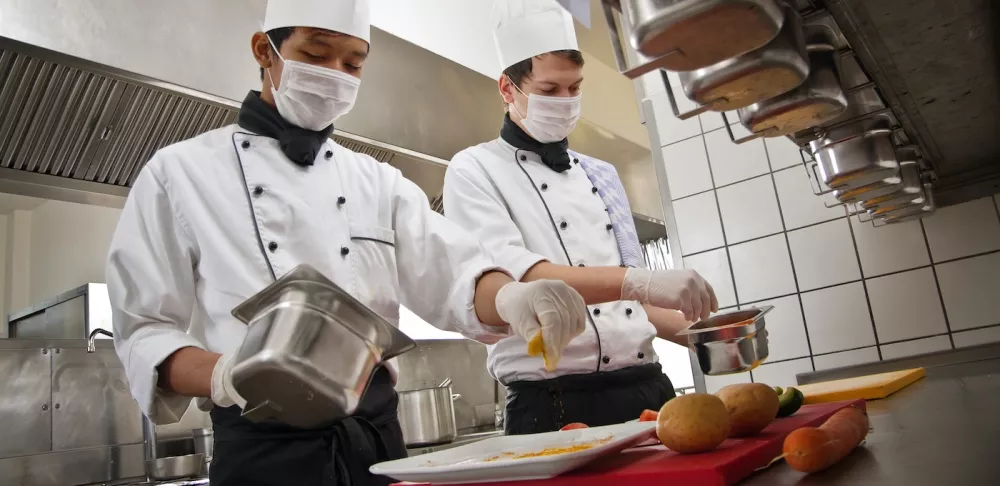California Governor Gavin Newsom announced reopening guidelines for restaurants on May 12 — two months after he issued a stay-at-home order that put a halt to dine-in operations. Now, restaurant owners and operators are navigating how to safely reopen their doors to diners craving a sit-down meal amid new rules and regulations.
The 12-page guidance document, available on the state’s website, directs restaurants, brewpubs, craft distilleries, breweries, bars, pubs and wineries on mandates for providing clean and safe environments for diners and workers. Businesses are advised to screen for COVID-19 symptoms (like taking workers’ temperatures before their shifts), update cleaning and sanitizing protocols, adhere to physical distancing and train employees on proper hand-washing and use of face coverings.
“Governor Newsom was a restaurateur prior to being in government,” says Mishel LeDoux, director of restaurant and hospitality management at our Los Angeles campus. “He’s not just listening to other experts, he gets it having been somebody who understands the financial implications and structural differences between fast-casual, bars and fine-dining establishments.”
Many establishments have been dormant since March 19 or pivoted to delivery and pick-up only, and operators must educate staff and guests on the new world order if reopening dine-in operations.
“Before reopening, restaurants should update their websites, add signage and marker points as to where people should stand, and mark areas where customers cannot enter,” Mishel explains. “They are not only protecting their guests but the employees as well.”
She recommends restaurants inform customers of the changes they will experience when dining in by setting up an automatic email reply for reservations and detail menu and operational changes on social media. “Make the messaging about being respectful to everyone,” she adds, advising disclaimers on disposable print menus to reiterate the new practices.
For an industry predicated on “service with a smile,” a masked host or server limits traditional communication. How can restaurant staff convey warm hospitality?
“I told my students, when I was a GM, I hugged and kissed hundreds of people a night,” Mishel says. “That is going to change.” She suggests front-of-house professionals evolve communication skills.
“Employees have to make that connection with people verbally and with eye contact,” she says, advising that staff remember clients’ names and focus on their tastes. Restaurants can use platforms like OpenTable and other technology to track diners’ preferences. If you know a guest likes to drink albariño, you can recommend a glass when greeting them. While bar areas still have to remain closed, alcohol can be served to diners.
Since diners won’t be cozying up to the bar for a pre-dinner beverage or racking up big bar tabs for group celebrations, Mishel suggests restaurants maximize the bar check with innovative strategies. “Maybe guests take a dessert home, that is prepped and ready to go, and the restaurant offers a tawny port for takeout,” she recommends.
With the rise in takeout and delivery, Mishel emphasizes the importance of packaging. “We are visual creatures, the way you deliver products to people should draw them in.”
Mishel also suggests restaurateurs collaborate with their teams for fresh perspectives and ideas, like branded spice rubs, sauces or jarred baking mixes. “Whether a partnership with another company or on your own, make it easy for the end user to understand,” she says. Ultimately, the goal is to maximize the diner’s check average. “Make that experience even more grand for guests with something they can bring home.”
Mishel believes strategic management is crucial now more than ever. “Chefs have to be ahead of the game,” she says. “They can’t just bust out a dish and scribble a menu description the way they used to. They will have to type something up, have good standard operating procedure (SOP), and provide training materials and documents to staff.”
The biggest question for industry operators is whether restaurants can turn a profit with these new dine-in restrictions.
“I think they can, but it depends on how savvy they were at controlling their costs prior to the pandemic,” Mishel predicts. “Restaurant groups and restaurateurs have to commit to understanding the new nuances of the business and come up with creative ideas, whether technology or selling new products like market baskets, merchandise or cocktails-to-go. Restaurants will really need to figure out ways to drive top-line sales to make money for the bottom line.”
Study food business strategies with Mishel in ICE's Restaurant & Culinary Management program.




